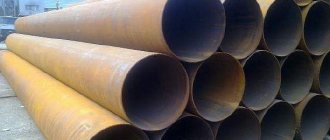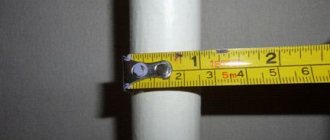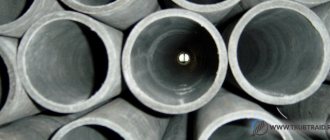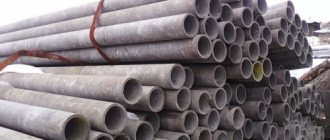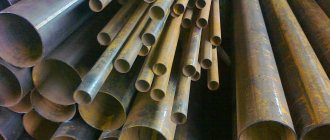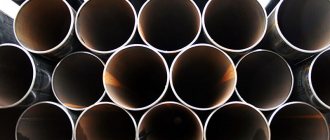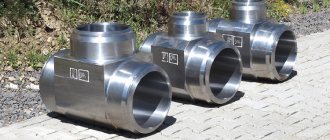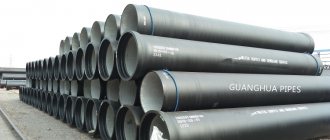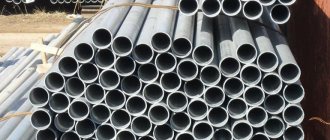By reading the numbers on the product, a specialist can determine the size of the pipe, its type, steel grade, strength, manufacturer and some other parameters of the product.
The marking of special purpose steel pipes contains additional markings.
Special purpose products include:
- Pipes made of alloy steel grades;
- Stainless;
- Drilling;
- Main gas pipelines;
- Boiler rooms, etc.
Stamp size
The height of the signs is from 5 to 30 mm, the width is from 3 to 12 mm - depending on the size of the pipe.
Classification
There is a conditional division into six classes:
1 - used for transporting low-pressure liquid and gaseous substances in irrigation systems. They make fences and supports, scaffolding, etc.
2 class - used in low and high pressure pipelines, for supplying petroleum products, gas and water.
3 class - works in conditions of high temperatures under pressure: heating boilers, petroleum cracking, nuclear technology.
4 class - thick-walled drill pipes that can withstand high torsional loads. They are used in the development of oil fields and other geological work.
5 The class is used in transport construction: carriages, cars, overhead cranes, drilling rigs and in furniture construction.
Class 6 – blanks used in mechanical engineering for the manufacture of: bearings, pump cylinders, receivers, etc.
Did you know that almost 90% of pipes manufactured in Russia are made of steel? Features of installing a pipeline made of steel pipes - read about methods of connecting pipes: soldering, fittings, couplings. Read about what is useful to know when soldering polypropylene water pipes here.
And here https://aquacomm.ru/vodosnabzenie/zagorodnyie-doma-v/avtonomnoe-vodosnabzhenie/trubyi/plastikovyie/press-kleshi.html you will find information about methods of connecting metal-plastic pipes - compression fitting, press fitting, press pliers.
The diameter of the pipe is distinguished as follows:
- Up to 114 mm – small diameter pipes;
- From 114 mm to 480 mm – medium;
- From 480 mm – large.
Diameter of steel pipes according to GOST R
Small diameter (up to 114 mm.).
Small diameter pipes are not marked. An accompanying label with information is attached to them. The same applies to cold-deformed pipes up to 450 mm - they are transported in bags, and a label is attached to the entire bag.
The label contains the following information:
Small diameter pipes with information label
- Recipient's name;
- Order No.;
- Date/shift;
- Package No.;
- Batch number;
- Size;
- Standard (TU or GOST);
- Steel grade;
- Heat number;
- Pieces (number of units in the package);
- Theoretical weight kg. (if the order is in meters);
- Actual weight;
- Meters (total length);
- Recipient code.
Medium diameter (114 – 480 mm)
Pipes with a wall thickness of 3.5 mm and a diameter of 159 mm are marked each separately. Cold-deformed pipes from 159 – 450 mm, as a rule, three products from the entire package are marked and a label is attached.
Example of a steel pipe label
Large diameter (from 480 mm)
Marking with a diameter of 530 mm or more is allowed on the inner surface.
If the wall thickness is more than 10 mm, marking on the end of the pipe is possible.
The color of the paint may indicate the grade of steel from which the pipe is made.
Marking of large diameter pipe on the inner surface
To make it easier to find the markings, they are usually highlighted with bright paint.
Example of boiler pipe marking color:
Steel grade:
- 20 – green;
- 20PV – blue;
- 15GS – brown;
- 15ХМ – yellow;
- 12Х1МФ – red;
- 12Х1МФ-ПВ – orange;
- 15Х1М1Ф – white;
- 12Х2МФСФ – blue.
An example of paint marking of a seamless casing pipe with a threaded connection in accordance with GOST 632.
The combination of numbers “146 (E) 7.7 1083 304 OTTM A” means:
- 146 – diameter;
- (E) – strength group. “E” in brackets means that ultrasonic testing has been performed;
- 7.7 – wall thickness;
- 1083 – length (then there is an indentation of 30-35 mm);
- 304 – mass;
- OTTM – type of connection (short triangular thread is not indicated);
- A – execution (written only if option A);
- At the end is the plant's trademark.
Marking of water pipes
The marking of gas supply pipes contains information about the diameter of the pipe, the presence of insulation, the presence and type of thread, as well as other necessary information.
Labeled water and gas pipes
Let's look at an example of branding Ts-R-25×2.8:
- C – galvanized surface;
- P – thread;
- 25×2.8 – (inner diameter) x (wall thickness).
International standard GOST R ISO 3183-1-2007
Pipes with a diameter of up to 48.3 mm inclusive are transported in bags, and the marking is applied with a stamp on a bandage or an attached metal label. The total length is indicated in meters and centimeters.
Requirements for pipes for pipelines according to GOST R ISO 3183-1-2007
Next, with a diameter of up to 406.4 mm, each pipe is marked with paint using a stencil on the outer surface. The length is indicated anywhere at the discretion of the manufacturer.
With a diameter of 406.4 mm inclusive and more, by default they are marked from the inside, unless the customer has specified another option. Apply using a stencil at a distance of 152.4 mm or more from the end of the pipe.
Marking of thick steel pipes at the end of the product
The stamp is not used to mark pipes closer than 25.4 mm from the weld:
- Steel strength groups above L175 without subsequent hardening;
- With a wall thickness of less than 4 mm.
Marking contains
- Manufacturer's trademark or name;
- Designation of the GOST R ISO 3183-1 standard (applied if the product fully complies);
- If it meets several standards, then all may be indicated;
- Designation of mass per linear meter;
- Steel class and strength group;
- Pipe forming method (S, W, F);
- Performed heat treatment;
- Test pressure (if tested above the standard pressure, this number is indicated in Pascals, after the word TESTED);
- There may be additional requirements.
Water supply systems made from steel pipes are used quite often, so you need to know about their properties and classification. Steel water supply pipes - sizes, diameters, materials, quality classes. You will learn about the technical characteristics of polyethylene pipes in this article.
Steel strength group
L320 and higher, with niobium content the letter C is indicated, vanadium - V, titanium - T.
Mechanical properties of materials for the manufacture of pipes - steel strength groups
The formation method or production process is indicated by:
S – seamless pipe; W – welded, except those made with a continuous seam; F – pipe made with a continuous weld.
Heat treatment is indicated by the following signs:
- Tempered and/or normalized pipe – N;
- Subcritical stress relief – HS;
- Subcritically cured – HA;
- Quenched and Tempered – Q.
The supplement includes
A paint spot with a diameter of 50 mm can be applied, which corresponds to the steel strength group, this applies to pipes over 114.3 mm in diameter, strength group L320 and higher.
Used color combinations for pipeline markings
Table of correspondence:
Pipes L415
- L320 - Black color;
- L360 - Green;
- L390 - Blue;
- L415 - Red;
- L450 - White;
- L485 - Violet;
- L555 - Yellow.
Reading example
"X GOST R ISO 3183-1-2007 14 54 57 L245 S"
Let's decipher:
- “X” – trademark;
- "GOST R ISO 3183-1-2007" - GOST;
- "14" - size;
- “54, 57” - mass;
- “L245” - steel strength group;
- "S" - seamless.
If the pipes have been subjected to treatment, such as heat treatment, then any markings that no longer correspond to the condition must be removed.
Couplings for products are also marked in accordance with standards and contain:
- Manufacturer's name;
- Steel strength group;
- Standard designation.
The threads on pipes are marked with a stamp or paint next to the thread; if the manufacturer of the pipe and thread are the same, then the trademark may be omitted.
Example of pipe marking with explanation
Thread marking according to GOST is carried out separately and does not give the right to claim that the entire product meets the same standard.
It can be quite difficult to understand all the intricacies of marking, but once you have mastered this “literacy”, one look at a steel pipe will be enough for you to learn everything, or almost everything, about it!
Purpose
Straight-seam electric-welded steel pipes (GOST 10704-91) are used for laying gas, water pipelines and manufacturing structural parts and heating systems. Galvanization can prevent corrosion of the material. It eliminates the hassle of maintenance and care. The use of such products allows you to increase their service life and improve safety, because this reduces the likelihood of leakage.
Such pipes are used to install pipelines with different flow and pressure indicators. Electric-welded pipe is also used to install gas pipelines that operate at low pressure. This should include water supply and heating networks.
The length of the pipe can vary from 4 to 12 m. Carbon steel pipes are used for laying pipelines and gas pipelines, the operating pressure of which does not exceed 16 MPa. The pipes can be based on calm, boiling or semi-quiet steel.
Another manufacturer and the cost of his products
For the consumer, one of the important factors when choosing is usually cost. If in front of you are steel water and gas pipes (GOST 10704-91), then you will have to pay 46 rubles for one of them. per square meter. In this case, we are talking about a product with parameters of 15 x 2.8 mm, while the weight of 1 meter will be equal to 1.28 kg. And for a ton the consumer will pay 36,000 rubles.
When the dimensions change to 20 x 2.8 mm, the weight becomes 1.66 kg. This is true for one meter of product. You can purchase it for 59.76 rubles. The price per ton remains the same. Pipes (GOST 10704-91) offers to purchase. This supplier offers a wide range of products. If you buy a water and gas pipe with dimensions equal to 50 x 3.5, then you will have to pay from 161 rubles per meter. The weight of 1 meter will be 4.88 kg.
More about the area of use
Electric welded products are used today in various fields of human activity, this can be construction and industry, as well as the tractor industry and the production of automobiles and metal structures. On a smaller scale is furniture manufacturing. The product will comply with the range and main features if GOST 10704-91 is used in its production. The pipe, the technical characteristics of which should be studied before purchasing products, is also used for the construction of playgrounds, as well as fences.
Production of welded pipe products
Electric-welded pipes are produced from steel strips (strips) on a rolling mill. Depending on the type of seam, pipe products are produced in two types:
- straight-seam - having one seam running straight along the entire metal product;
- spiral welded - also having one seam, but rotating along the entire length in the shape of a spiral around the pipe being welded.
The most common are straight-seam steel pipe products. Their main advantage is the minimum length of the weld (compared to spiral welds), which simplifies the quality control required during production. Spiral welded pipes are often of large diameters and are produced solely for the reason that there is no wide blank (steel sheet or strip) for the production of longitudinally welded pipes.
The technological process of manufacturing electric-welded metal structures itself is quite labor-intensive; it consists of many complex operations. To produce high-quality pipes of different diameters, radio frequency welding is most often used, which connects metal at high speed. With this welding method, high-voltage currents are passed through the workpiece, which contribute to the rapid heating of the edges being joined.
In order for a strong and high-quality weld to be formed from the molten workpiece, or rather, from its edges, they are pressed tightly against each other under pressure. And to obtain a pipe of the required diameter from a steel strip, special machines and crimping mills are used in metallurgical production. This manufacturing technology allows us to obtain not only reliable and high-quality products, but also provide them with an attractive appearance. The welded seam on these products looks very neat or even invisible.
Classification according to physical and chemical properties
Today, there are four known groups into which electric-welded pipes are divided. Group A includes those that have certain mechanical properties. But if the product belongs to group B, then it must have special chemical properties. Pipes will have certain chemical compositions and special mechanical properties if they belong to group B. When pipes are needed that meet hydraulic pressure standards, the consumer chooses those that represent group G.
